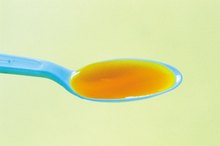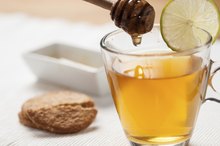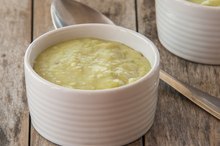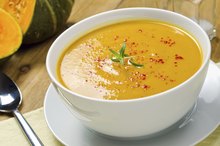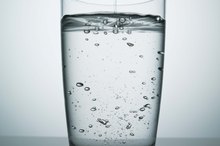Thickened Liquid Diet
If you have difficulty chewing or swallowing, you may need a thickened liquid diet. Your doctor may suggest you be evaluated by a speech language pathologist before changing the consistency of your liquids, according to the National Institutes on Deafness and Other Communication Disorders. Difficulty chewing or swallowing is known as dysphagia.
Dysphagia
Dysphagia occurs when there is a problem with the swallowing process, such as a weakened tongue muscle or the inability to stimulate the swallowing reflex. Strokes and diseases of the nervous system, such as cerebral palsy, are the most common causes of dysphagia. If you have dysphagia, you are at risk for aspiration pneumonia and malnutrition, according to the National Institute on Deafness and Other Communication Disorders. Modified diets, like thickened liquids, minimize your risk.
- Dysphagia occurs when there is a problem with the swallowing process, such as a weakened tongue muscle or the inability to stimulate the swallowing reflex.
- If you have dysphagia, you are at risk for aspiration pneumonia and malnutrition, according to the National Institute on Deafness and Other Communication Disorders.
Levels of Thickness
The Nectar Liquid Diet
Learn More
There are four levels of liquid thickness, according to the Ohio State University Medical Center. Thin liquids include water, soda, juice and broth. Nectar thick liquids include:
- fruit nectar
- maple syrup
- eggnog
- Ensure
- tomato juice
- cream soups
Honey thick liquids include honey and liquids thickened to a honey consistency. A spoon thick liquid is a pudding. The speech language pathologist and doctor determine the thickened liquid you need.
- There are four levels of liquid thickness, according to the Ohio State University Medical Center.
Thickening Liquids
Some liquids, such as eggnog, are naturally thickened to the appropriate consistency. Other liquids need a thickening agent to reach the right consistency. There are two types of thickeners, starch thickeners and gel-based thickeners, according to the Ohio State University Medical Center. Starch thickeners come in powdered form. Starch thickeners work best when limiting the liquid amount to 4 ounces, says the OSU Medical Center. Gel-based thickeners are more costly than starch thickeners but work more quickly and consistently. Thickeners can be found over the counter at most pharmacies. It is important to closely follow the directions on the package when mixing the liquids to the correct consistency.
- Some liquids, such as eggnog, are naturally thickened to the appropriate consistency.
- Other liquids need a thickening agent to reach the right consistency.
Adequacy of the Diet
Honey-Thickened Liquid Diet
Learn More
Thickened liquid diets provide adequate nutrition. However, when you have dysphagia you may have some difficulty taking in enough nutrients to meet your needs. You need 6 to 8 cups of fluid a day, according to Jackson/Siegelbaum Gastroenterology. Taking in less than 4 cups may require medical intervention. If you are unable to eat enough calories and protein, you can add calorie and protein boosters, such as dried milk powder and strained baby food, to increase the caloric density of your food.
- Thickened liquid diets provide adequate nutrition.
- If you are unable to eat enough calories and protein, you can add calorie and protein boosters, such as dried milk powder and strained baby food, to increase the caloric density of your food.
Considerations
If you are having difficulty swallowing and need thickened liquids, there are some guidelines regarding safe swallowing. First, it is important to eat all meals in an upright position; this will make sure food goes into the stomach and not the lungs, according to Jackson/Siegelbaum. Take small bites and eat slowly. Try to eat in a relaxed environment and do not talk when you have food in your mouth. After each meal, try to stay in your upright position for at least 30 minutes.
- If you are having difficulty swallowing and need thickened liquids, there are some guidelines regarding safe swallowing.
- Try to eat in a relaxed environment and do not talk when you have food in your mouth.
Related Articles
References
- Cichero JA. Thickening agents used for dysphagia management: effect on bioavailability of water, medication and feelings of satiety. Nutr J. 2013;12:54. doi:10.1186/1475-2891-12-54
- Badenduck LA, Matthews TW, McDonough A, et al. Fiber-optic endoscopic evaluation of swallowing to assess swallowing outcomes as a function of head position in a normal population. J Otolaryngol Head Neck Surg. 2014;43(1):9. doi:10.1186/1916-0216-43-9
- Garcia JM, Chambers E. Managing dysphagia through diet modifications. Am J Nurs. 2010;110(11):26-33. doi:10.1097/01.NAJ.0000390519.83887.02
- Intermountain Healthcare. (2014). Dysphagia.
- Mills, R. H. (2008, October 14). Dysphagia Management: Using Thickened Liquids. The ASHA Leader.
- Speech Pathology Australia. Australian Standards for Texture Modified Foods and Fluids.
Writer Bio
Jill Corleone is a registered dietitian and health coach who has been writing and lecturing on diet and health for more than 15 years. Her work has been featured on the Huffington Post, Diabetes Self-Management and in the book "Noninvasive Mechanical Ventilation," edited by John R. Bach, M.D. Corleone holds a Bachelor of Science in nutrition.
